Once you’ve built a product your customers love and the marketing and sales teams are collecting leads and converting customers, your next step is likely order fulfillment. That’s when you process the order and deliver it to the customer, all while monitoring each stage of the process for smooth delivery.
Ideally, order fulfillment should be as smooth as possible. With a disorganized order fulfillment process, customers may grow dissatisfied and seek out competitors to handle their needs.
In the next few minutes, we’ll break down this topic piece-by-piece, provide an outline for streamlined order fulfillment, and provide a few efficiency-boosting tips and tricks along the way. Let’s start at the beginning.
What is order fulfillment?
Order fulfillment is the operational routine a company follows when accepting, processing, and shipping the orders they receive to end customers.
It can be performed internally, or by an order fulfillment company. A fulfillment provider will typically take on the physical handling and delivery of the goods in the warehouse, but your company will provide any essential data and instruction.
This process is mostly relevant to ecommerce companies with physical products, though service companies can utilize some individual order fulfillment practices to deliver their services.
We can break down the fulfillment operation into distinct parts with some important additional consideration. We’ll get to that last part a bit later on. First, let’s go through the process.
How does the order fulfillment process work?
As mentioned above, we can split the order fulfillment process into three steps: accepting, processing, and shipping orders. Let’s go through each stage and what it can look like.
1.Receiving
This is the first link in your supply chain, where your inventory is received by your storage location, which may be a warehouse. Here’s an example table for received orders:
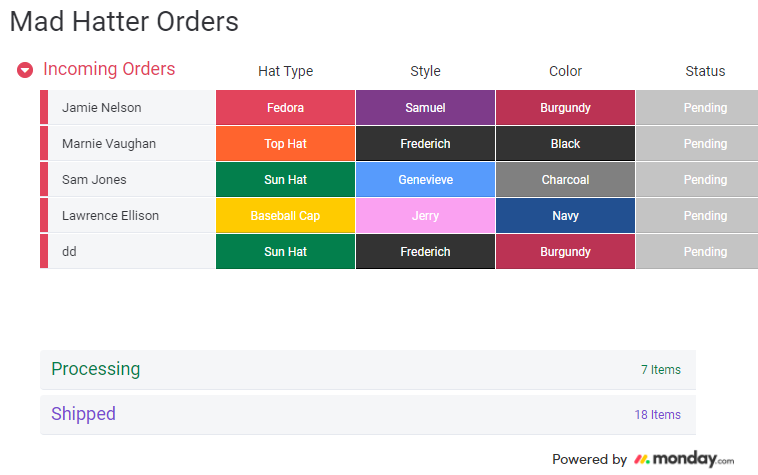
In this stage, it is important to inspect your inventory to make sure every item is accounted for and hasn’t been damaged in transit.
Next, you may want to track whatever form of stock tracking data you are using, whether it’s SKUs (stock keeping units) and/or barcodes. This will help you track and manage the inventory on the front end.
In this stage, you will organize the storage of your goods, making sure to group everything in their relevant categories and dedicate a space for ‘processing,’ which brings us to the next stage.
2. Processing
Now that you have an order, you need to communicate that information with the warehouse. Many companies link their ordering system with the fulfillment warehouse directly, so that when they receive a customer order, the warehouse is automatically notified.
A warehouse employee will read the order sheet and pick the relevant items up from storage to take them to the packing station. This is called order picking.
At this stage, an employee will complete a final quality check for the items, and seal them in the box ready for the last stage — shipping—and when documenting the process—can look like the following:
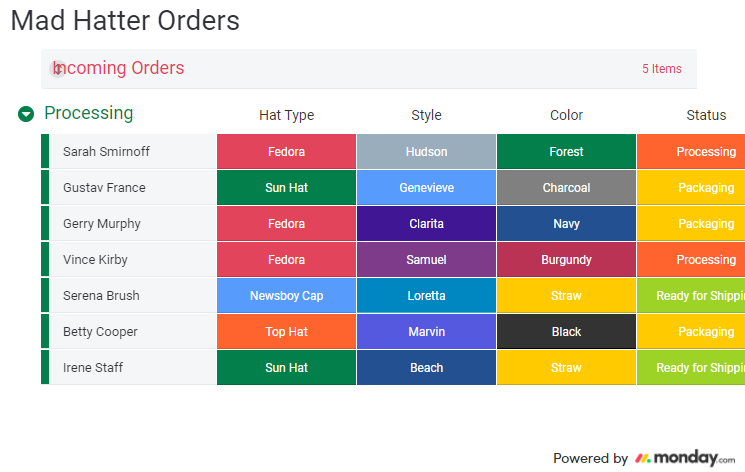
3. Shipping
Once your goods are packed, taped, and labeled, you will weigh the entire package. You can take the shipment weight to different delivery partners to find the best shipping cost quote according to your preferred shipping method.
Once it’s sent, the customer will begin to receive order updates from your delivery partner until it reaches its destination.
At this stage, you can change the order status to fulfilled or shipped, as shown below.
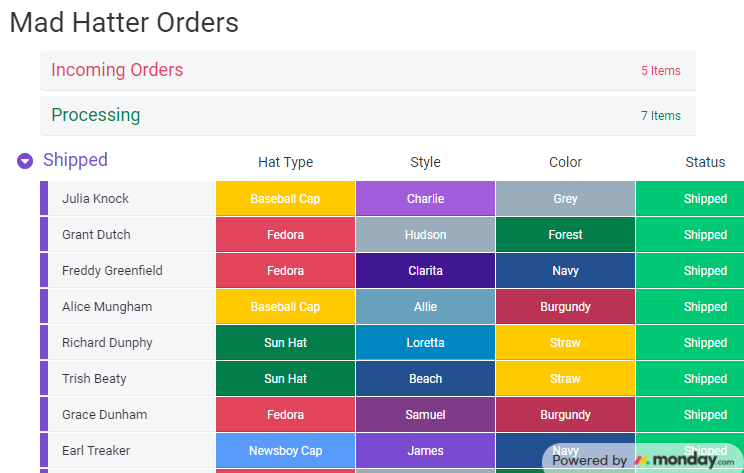
There’s just one more factor to take into consideration.
Returns
Despite its powerful effects on buying confidence and customer satisfaction, returns are often overlooked.
But order fulfillment isn’t finished without integrating a returns process. This is because without a returns process, you’ll have to go back to square one if the customer’s products are defective and you need to send out a replacement.
No matter what kind of good you’re providing, it’s in the best interest of your company and your customers to have a clearly written customer-facing returns policy. Some businesses also send customers a link to their returns process post purchase.
Their choices should trigger actions that instate a refund or begin the process of fulfilling another order.
We’ve covered basics of the order fulfillment process. Now it’s time to go deeper and uncover methods for making order processing logistics not only faster, more efficient, and automated, but also much easier.
Tips to improve order fulfillment
If you’re not using an order fulfillment service, there’s another option that will help you streamline and manage the entire process from start to finish.
With a robust software, you can handle inventory management, customer service, order processing, multiple orders, automated communications, real-time updates, and returns notifications.This not only relieves a lot of labor from performing repetitive administrative stuff, but also reduces the potential for human error, which occurs more regularly in the number and data-lead practice of order fulfillment.
There are plenty of good software solutions out there that can capably handle the order fulfillment process. Let’s take a look at some essential assets that will help save you time, money, and retain your customers.
Flexible order management
Order management is the base of your operations. It’s where you store key information on placed orders. You can then use this database to instruct the other elements of the process. Each record within this system is more than just a transaction; it represents a customer’s decision to trust your product or service. As such, managing these orders efficiently is not just about fulfilling requests, but about nurturing these customer relationships.
Because every company is different—think of all the various return policies, shipping solutions, lead-times and so on—you may want to consider an order management platform that is flexible enough to account for these differences. Ideally, you could design the order management table according to your business’s needs, not the other way around.
A powerful Work OS can provide all the flexibility you need, plus additional features for maximum performance.
monday.com: build a real-time inventory management solution
With monday.com, you can create any solution you need for any process, including a robust order fulfillment system. Easily see important information such as order date or delivery address at a glance. Filter your board to only show certain information, add custom statuses, and more.
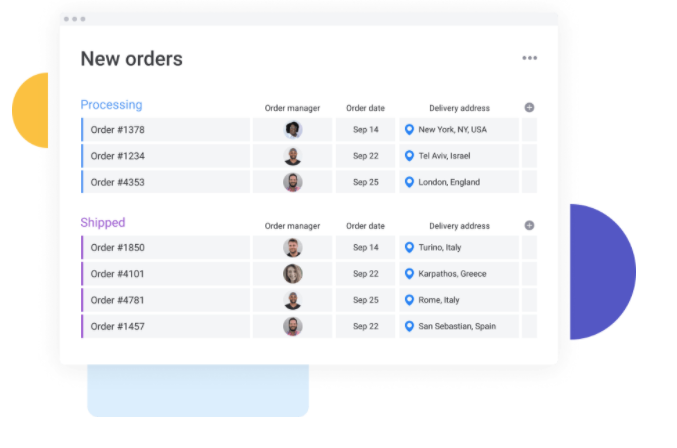
With monday.com, your order management table is just that — yours.
We’ve made it completely customizable to your needs, meaning you can add and edit columns according to the design of your order fulfillment system with drag-and-drop simplicity.
Customer communication
Next, it’s important to look for customer communications and warehouse software that can handle the necessary communications relating to order fulfillment, both internally and externally.
Communication is an essential component that has a presence in each step of the order fulfillment process.
Customers need to know when their order has been placed, warehouse employees need to know when an order has been accepted, and your logistics provider needs to know the order volume.
Typically, communication is handled by software in one of two ways: directly on the platform, or via integrations from external communication apps. A combination of both is the optimal mix, with internal communication happening both on the platform, and externally via integrations.
monday.com: keep customers in the loop with integrations
monday.com lets you connect all of your favorite tools to the platform, so you can oversee the entire order fulfillment process and send out vital communications all in one place.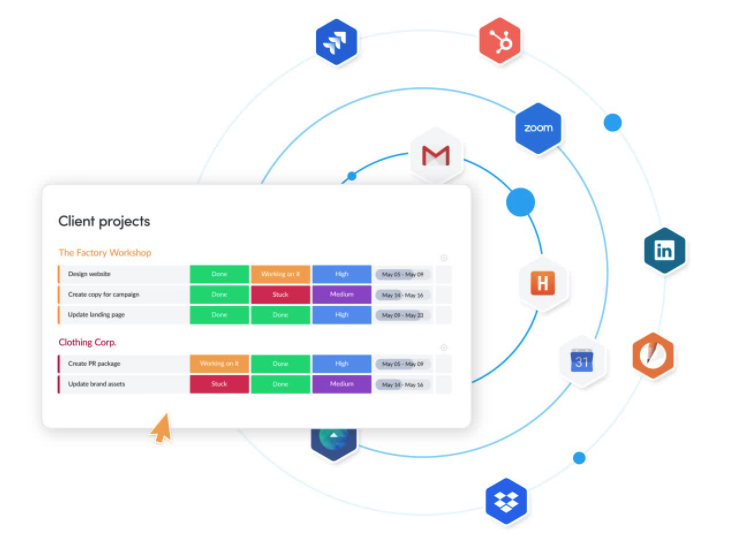
Connect Slack to coordinate internally, Gmail to easily connect with your customers, and Salesforce, Zendesk, or Shopify to manage customer relationships. Without needing to switch tabs, you can help your employees save time and confusion from needing to open and close different solutions.
Everything you need for smooth communications is one one platform.
Automations
Automations are actions that are performed automatically as a result of a pre-defined behavior.
Let’s use an example from inventory management. You could have your software send an email to suppliers to trigger another inventory round when ‘inventory’ reaches a certain value — such as less than 5 units.
The applications of automations are endless, and an intelligent automation can not only save you untold amounts of time and labor, but also money.
monday.com: automations to set order fulfillment to ‘easy-mode’
To date, monday.com has saved over 386 million human actions through intelligent automations. And the process is simple. Once you enter your workspace, you can select the Workflows option from the Board Power-Ups menu and create your own custom recipe in seconds.
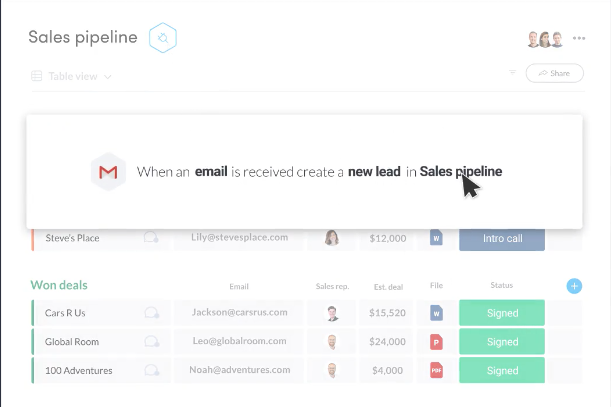
Trigger fulfillment steps, inventory level notifications, and more.
Simplify order fulfillment with monday.com
By now, we’ve gained an understanding of the order fulfillment process and how monday.com is suited to making it not only more efficient, but also easier.
Order fulfillment is both a science and an art. The data-driven practice of inventory and sales management merges with the human touch of customer relationship management to create an order system that works. On monday.com, we let you automate the routine work and easily access data-driven dashboards for smart decision-making, so you can focus on fostering lasting relationships with customers.
To jump right in and start creating your solution, head on over to our order management template.


